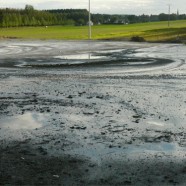Happy sailing in a toxic trail
MSC Flaminia
Press release # 9
PCB waste has burned in the fire following from the explosion of a container onboard MSC Flaminia on July 14th 2012 (see press release Robin De Bois, August 29, 2012). The fire raged for several days. The ship was then approximately 1800 km away from the English and French coasts. The burning of PCB generates dioxins that increased the overall toxicity of the emissions in the air and dispersed in the sea. (cf. introduction to the list of hazardous materials aboard MSC Flaminia). It is likely that the extinguishing waters inside the vessel contain PCB residues and dioxins mixed with other pollutants.
Hazardous Materials Onboard the MSC Flaminia
MSC Flaminia
Press Realease # 8
MSC Flaminia is a floating logistic warehouse. Its counterpart ground project would be subject to the Seveso Directive with strict regulation concerning construction and organizational requirements; such as fireproof walls, isolation distances between classes of hazardous materials, an internal organisation plan, a specific response plan including the intervention of external emergency resources. Fires in Seveso type plants on land requires the evacuation of people and the implementation of safety measures touching on the consumption of food produced in a perameter that can sometimes range quite far.
PCBs on board the MSC Flaminia
MSC Flaminia
Press release # 7
Update August 30, 9:45 am
The complete inventory of hazardous materials on board the MSC Flaminia has been made by an unofficial source. No radioactive material is declared. However, the big surprise is the presence of two PCB waste containers on board outside the damaged area. These PCBs are banned from production and use worldwide. They were undoubtedly intended for disposal in Europe. They came clearly the United States, since MSC Flaminia left Charleston. It is surprising that the United States would expose the marine environment to known high risks by transporting and exporting hazardous waste to Europe. Exportation from the United States to Europe is not illegal as long as done in accordance to the Basel Convention on transborder movements of hazardous waste. But it is illogical.
Ban on Perchlorethylene : a fake measure
The Ministry for Ecology has put together a plan confirming the use of perchlorethylene, a solvent that is toxic for humans and the environment, until 2028. As a result, all Laundromat owners buying dry cleaning equipment containing perchlorethylene until the deadline of January 1st 2013 will be able to use it for fifteen years.
The text is so complicated and tangled that the members of the High Council for Technological Risks Prevention, on their June 26th 2012 meeting, only discovered this deadline after two and a half hours of debate.
The PCB Cookbook
Wearing their top chef’s hats, Ifremer, the General Department for Food, the Management of Maritime Fishing, and waterlife have made for you, just in time for New Year’s celebrations, a dish of the highest quality. It is recommended that you consume crabs fished from the depths of the Seine’s bay, and no longer adhere to the opinion of the National Agency for the Sanitation of Food, Work, and the Environment (ANSES) from May 13, 2011, and to forget the prefect of Haut-Normandie’s decree from July 29, 2011. According to the former, the crabs were considered not to conform to the regulated standards of polychlorinated biphenyl (PCB) and dioxin content, and the latter forbid both consumption and marketing.
Crabs Pinched by PCB
The port of Rouen wants to open a new disposal site for the sludge from dredging in the Seine’s bay. The public inquiry was closed yesterday. This 2 million meters³ “experience” covers itself in scientific fuss like the follow-up of the bioaccumulation of toxic elements contained in the sludge, thanks to the placing of 7 cages of mussels laid 2 to 10 km from the disposal site. This animal experimentation led by Ifremer is totally useless in regards to the ecological disaster that strikes a blow from heavy metals and PCB, endocrinal disruptors, at the ensemble of the Seine’s bay from the east to the west and from the top to the bottom.










